|
|

|
|
Author
|
Topic: ISRO's Chandraayan-1 to orbit the moon
|
Robert Pearlman
Editor Posts: 42988
From: Houston, TX
Registered: Nov 1999
|
 posted 09-18-2008 09:32 AM
posted 09-18-2008 09:32 AM
   
Weather permitting, India's maiden moon mission, Chandrayaan-1, may lift off Oct. 19 from Sriharikota in Andhra Pradesh, scientists associated with the odyssey indicated Thursday, reports IANS. Chandrayaan-1 will be launched by indigenous Polar Satellite Launch Vehicle (PSLV) and will carry payloads of six foreign countries — the US, Britain, Germany, Sweden and Bulgaria — apart from those of India.Scientists said that the Chadrayaan-1 spacecraft will be shipped later this month, most likely on Sep 30, to the Satish Dhawan Space Centre at Sriharikota for the launch. 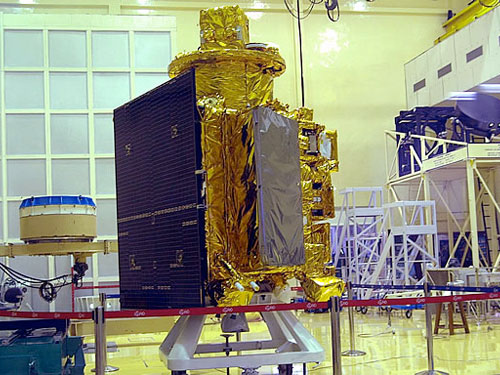 |
Robert Pearlman
Editor Posts: 42988
From: Houston, TX
Registered: Nov 1999
|
 posted 10-20-2008 08:43 PM
posted 10-20-2008 08:43 PM
   
NASA release NASA Returns to the Moon with Instruments on Indian SpacecraftTwo NASA instruments to map the lunar surface will launch on India's maiden moon voyage. The Moon Mineralogy Mapper will assess mineral resources, and the Miniature Synthetic Aperture Radar, or Mini-SAR, will map the polar regions and look for ice deposits. The Indian Space Research Organization, or ISRO, is scheduled to launch its robotic Chandrayaan-1 on Oct. 22 from Sriharikota, India. Data from the two instruments will contribute to NASA's increased understanding of the lunar environment as it implements the nation's space exploration policy, which calls for robotic and human missions to the moon. "The opportunity to fly NASA instruments on Chandrayaan-1 undoubtedly will lead to important scientific discoveries," NASA Administrator Michael Griffin said. "This exciting collaboration represents an important next step in what we hope to be a long and mutually beneficial relationship with India in future civil space exploration." The Moon Mineralogy Mapper is a state-of-the-art imaging spectrometer that will provide the first map of the entire lunar surface at high spatial and spectral resolution, revealing the minerals that make up the moon's surface. Scientists will use this information to answer questions about the moon's origin and geological development, as well as the evolution of terrestrial planets in the early solar system. The map also may be used by astronauts to locate resources, possibly including water, that can support exploration of the moon and beyond. The Mini-SAR is a small imaging radar that will map the permanently shadowed lunar polar regions, including large areas never visible from Earth. The Mini-SAR data will be used to determine the location and distribution of water ice deposits on the moon. Data from the instrument will help scientists learn about the history and nature of objects hitting the moon, and the processes that throw material from the outer solar system into the inner planets. The spacecraft also will carry four instruments and a small lunar impactor provided by ISRO, and four instruments from Europe. ISRO will launch the vehicle into a lunar polar orbit for a two-year mission. In addition to the two science instruments, NASA will provide space communications support to Chandrayaan-1. The primary location for the NASA ground tracking station will be at the Johns Hopkins University Applied Physics Laboratory in Laurel, Md. |
Robert Pearlman
Editor Posts: 42988
From: Houston, TX
Registered: Nov 1999
|
 posted 10-21-2008 04:16 AM
posted 10-21-2008 04:16 AM
   
PSLV-C11 on its way and at the launch pad (credit: ISRO):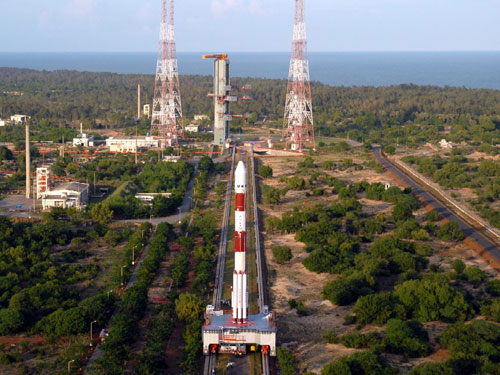 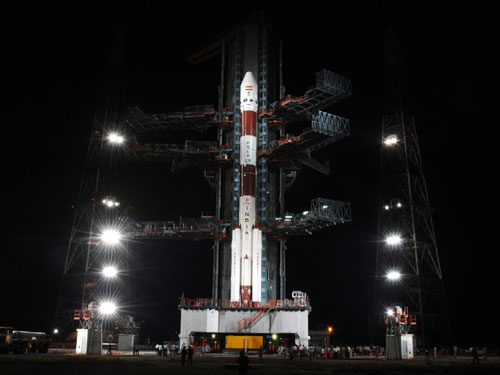
|
Robert Pearlman
Editor Posts: 42988
From: Houston, TX
Registered: Nov 1999
|
 posted 10-21-2008 10:16 PM
posted 10-21-2008 10:16 PM
   
Times of India: Chandrayaan-I launched successfully Chandrayaan-1, India's maiden moon spacecraft, was on Wednesday put into Transfer Orbit around the earth by the Polar Launch Vehicle PSLV-C11 about 19 minutes after it blasted off from the Satish Dhawan Space Centre here.The 1,380 kg Chandrayaan-1, carrying 11 payloads, was released into a Transfer Orbit at a perigee (nearest point to earth) of about 250 km and apogee (farthest point from the earth) of about 23,000 km, 18.2 minutes after the PSLV-C11 blasted off as the scientists broke into jubilation at the mission control centre. After a series of procedures over the next two weeks, the spacecraft would reach its desired Lunar orbit and placed at a height of 100 km from the Lunar surface, marking the operational phase of the mission which would put India in the elite lunar club. 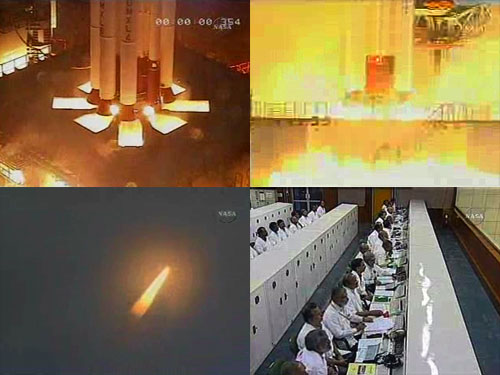 |
Robert Pearlman
Editor Posts: 42988
From: Houston, TX
Registered: Nov 1999
|
 posted 10-21-2008 10:28 PM
posted 10-21-2008 10:28 PM
   
The Indian Space Research Organization (ISRO) outlines how Chandrayaan-1 will reach the Moon: After circling the Earth in its Initial Orbit for a while, Chandrayaan-1 spacecraft is taken into two more elliptical orbits whose apogees lie still higher at 37,000 km and 73,000 km respectively. This is done at opportune moments by firing the spacecraft's Liquid Apogee Motor (LAM) when the spacecraft is near perigee. Subsequently, LAM is fired again to take Chandrayaan-1 spacecraft to an extremely high elliptical orbit whose apogee lies at about 387,000 km. In this orbit, the spacecraft makes one complete revolution around the Earth in about 11 days. During its second revolution around the Earth in this orbit, the spacecraft will approach the Moon's North pole at a safe distance of about a few hundred kilometers since the Moon would have arrived there in its journey round the Earth. Once the Chandrayaan-1 reaches the vicinity of the Moon, the spacecraft is oriented in a particular way and its LAM is again fired. This slows down the spacecraft sufficiently to enable the gravity of the moon to capture it into an elliptical orbit. Following this, the height of the spacecraft's orbit around the moon is reduced in steps. After a careful and detailed observation of perturbations in its intermediate orbits around the moon, the height of Chandrayaan-1 spacecraft's orbit will be finally lowered to its intended 100 km height from the lunar surface. Later, the Moon Impact Probe will be ejected from Chandrayaan-1 spacecraft at the earliest opportunity to hit the lunar surface in a chosen area. Following this, cameras and other scientific instruments are turned ON and thoroughly tested. This leads to the operational phase of the mission. This phase lasts about two years during which Chandrayaan-1 spacecraft explores the lunar surface with its array of instruments that includes cameras, spectrometers and SAR.
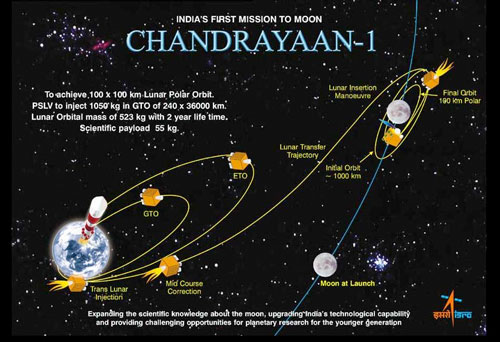 |
SpaceAholic
Member Posts: 4437
From: Sierra Vista, Arizona
Registered: Nov 1999
|
 posted 11-06-2008 10:14 AM
posted 11-06-2008 10:14 AM
   
Science Daily: Chandrayaan-1 Now In Lunar Transfer Trajectory On Nov. 4, following a fifth orbit-raising manoeuvre, the Chandrayaan-1 spacecraft successfully settled into a trajectory that will take it to the Moon.After launch on 22 October, the spacecraft was first injected into an elliptical 7-hr orbit around Earth, between 255 km and 22 860 km above our planet. After five engine firings, Chandrayaan-1 spiralled outwards in increasingly elongated ellipses around Earth, until it reached its lunar transfer orbit on 4 November at 00:26 CET (04:56 Indian standard time). In the fifth and last orbit-raising manoeuvre, the spacecraft's 440 Newton liquid-fuel propelled engine was fired for about two and a half minutes. The lunar transfer orbit's farthest point from Earth is about 380 000 km. |
Robert Pearlman
Editor Posts: 42988
From: Houston, TX
Registered: Nov 1999
|
 posted 11-08-2008 01:03 PM
posted 11-08-2008 01:03 PM
   
Indian Space Research Organization release Chandrayaan-1 Successfully Enters Lunar OrbitChandrayaan-1, India's first unmanned spacecraft mission to moon, entered lunar orbit today (November 8, 2008). This is the first time that an Indian built spacecraft has broken away from the Earth's gravitational field and reached the moon. This historic event occurred following the firing of Chandrayaan-1 spacecraft's liquid engine at 16:51 IST for a duration of 817 seconds. The highly complex 'lunar orbit insertion manoeuvre' was performed from Chandrayaan-1 Spacecraft Control Centre of ISRO Telemetry, Tracking and Command Network at Bangalore. Indian Deep Space Network (IDSN) at Byalalu supported the crucial task of transmitting commands and continuously monitoring this vital event with two dish antennas, one measuring 18 m and the other 32 m. Chandrayaan-1's liquid engine was fired when the spacecraft passed at a distance of about 500 km from the moon to reduce its velocity to enable lunar gravity to capture it into an orbit around the moon. The spacecraft is now orbiting the moon in an elliptical orbit that passes over the polar regions of the moon. The nearest point of this orbit (periselene) lies at a distance of about 504 km from the moon's surface while the farthest point (aposelene) lies at about 7502 km. Chandrayaan-1 takes about 11 hours to go round the moon once in this orbit. The performance of all the systems onboard Chandrayaan-1 is normal. In the coming days, the height of Chandrayaan-1 spacecraft's orbit around the moon will be carefully reduced in steps to achieve a final polar orbit of about 100 km height from the moon's surface. Following this, the Moon Impact Probe (MIP) of the spacecraft will be released to hit the lunar surface. Later, the other scientific instruments will be turned ON sequentially leading to the normal phase of the mission. It may be recalled that Chandrayaan-1 spacecraft was launched on October 22, 2008 by PSLV-C11 from India's spaceport at Satish Dhawan Space Centre (SDSC) SHAR, Sriharikota. As intended, PSLV placed the spacecraft in a highly oval shaped orbit with a perigee (nearest point to Earth) of 255 km and an apogee (farthest point to Earth) of 22,860 km. In the past two weeks, the liquid engine of Chandrayaan-1 has been successfully fired five times at opportune moments to increase the apogee height, first to 37,900 km, then to 74,715 km, later to 164,600 km, after that to 267,000 km and finally to 380,000km, as planned. During this period, the Terrain Mapping Camera (TMC), one of the eleven payloads (scientific instruments) of the spacecraft, was successfully operated twice to take the pictures, first of the Earth, and then moon. With today's successful manoeuvre, India becomes the fifth country to send a spacecraft to Moon. The other countries, which have sent spacecraft to Moon, are the United States, former Soviet Union, Japan and China. Besides, the European Space Agency (ESA), a consortium of 17 countries, has also sent a spacecraft to moon. |
Robert Pearlman
Editor Posts: 42988
From: Houston, TX
Registered: Nov 1999
|
 posted 11-14-2008 02:31 PM
posted 11-14-2008 02:31 PM
   
Indian Space Research Organization release Indian Tricolour Placed on the MoonIn a historic event, the Indian space programme achieved a unique feat today (November 14, 2008) with the placing of Indian tricolour on the Moon's surface on Pandit Jawaharlal Nehru's birthday. The Indian flag was painted on the sides of Moon Impact Probe (MIP), one of the 11 payloads of Chandrayaan-1 spacecraft, that successfully hit the lunar surface today at 20:31 hours (8:31 p.m.) IST. This is the first Indian built object to reach the surface of the moon. The point of MIP's impact was near the Moon's South Polar Region. It may be recalled that the modern Indian space programme was initiated in 1962 when Pandit Jawaharlal Nehru was the Prime Minister of India. 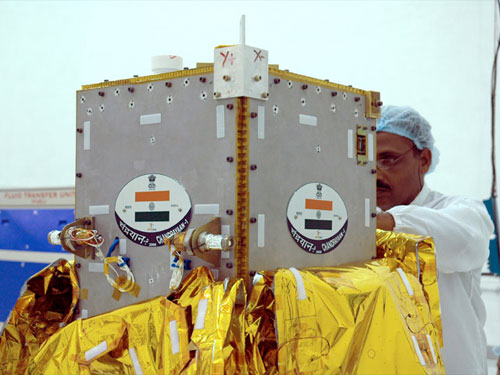 Weighing 34 kg at the time of its launch onboard Chandrayaan-1, the box shaped MIP carried three instruments - a video imaging system, a radar altimeter and a mass spectrometer. The video imaging system was intended to take the pictures of the moon's surface as MIP approached it. The radar altimeter was included to measure the rate of descent of the probe to the lunar surface. Such instruments are necessary for future lunar soft landing missions. And, the mass spectrometer was for studying the extremely thin lunar atmosphere. MIP's 25 minute journey to the lunar surface began with its separation from Chandrayaan-1 spacecraft at 20:06 hrs (8:06 pm) IST. This was followed by a series of automatic operations that began with the firing of its spin up rockets after achieving a safe distance of separation from Chandrayaan-1. Later, the probe slowed down with the firing of its retro rocket and started its rapid descent towards the moon's surface. Information from the its instruments was radioed to Chandrayaan-1 by MIP. The spacecraft recorded this in its onboard memory for later readout. Finally, the probe had a hard landing on the lunar surface that terminated its functioning. Thus, India's very first attempt to send a probe to the moon's surface from its spacecraft orbiting the moon has been successfully concluded. With the switching ON of two of Chandrayaan-1's payloads - Terrain Mapping Camera (TMC) and Radiation Dose Monitor (RADOM) - on its journey to moon and with MIP's successful impact on the lunar surface today, it is planned to switch ON and test the remaining eight payloads of the spacecraft in the coming few days. It may be recalled that Chandrayaan-1 was successfully launched by PSLV-C11 on October 22, 2008 from India's spaceport at Satish Dhawan Space Centre SHAR, Sriharikota into its intended initial elliptical orbit around the Earth. Following this, the spacecraft's orbit was raised in steps and it was made to pass near the moon by repeatedly firing its 440 Newton liquid engine. After Chandrayaan-1's entry into its planned lunar orbit on November 8, 2008, the orbital height was reduced in steps to its intended operational altitude of 100 km from the lunar surface. Since its launch, the health and orbit of Chandrayaan-1 is being continuously monitored from the Spacecraft Control Centre of ISRO's Telemetry, Tracking and Command Network (ISTRAC) at Bangalore with critical support from antennas of Indian Deep Space Network (IDSN) at Byalalu. IDSN antennas have also received the images and scientific information gathered by TMC, RADOM, and more recently, by MIP. 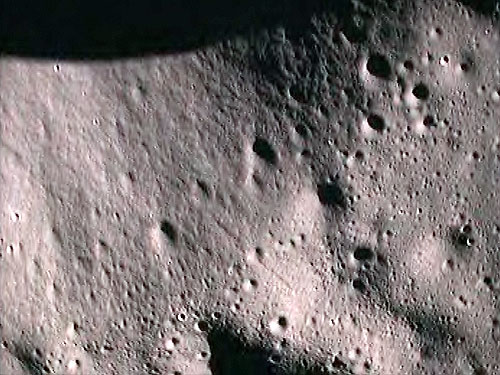 Close-up of the moon's surface taken by Moon Impact Probe as it approached. |
SpaceAholic
Member Posts: 4437
From: Sierra Vista, Arizona
Registered: Nov 1999
|
 posted 11-14-2008 03:54 PM
posted 11-14-2008 03:54 PM
   
Times of India: Mission Accomplished: India fifth in world to reach moon The tricolour landed on the Moon at 8.31 pm on Friday, opening a new chapter in the history of India's space exploration. The tricolour was painted on all sides of the 29 kg Moon Impact Probe (MIP) which was attached to the top portion of the main lunar orbiter, Chandrayaan. The MIP is the brainchild of former President A P J Abdul Kalam who witnessed its separation from the main orbiting craft and its crashlanding 32 km from the Shackleton crater on the moon's south pole from the mission control room at ISRO's telemetry, tracking and command network (ISTRAC) in Bangalore. ISRO officials told TOI that the countdown for the MIP's much-awaited flight to the surface of the Moon began at 7.47 pm. It went off smoothly and at 8.01 pm the command was issued for it to separate from the orbiting spacecraft. The MIP began its flight towards the Moon's south pole and after a 25-minute flight, crashlanded. During its flight, its video camera took pictures of the Moon, the spectrometer began its analysis and the altitude meter did what is known as a ranging. While approaching the Moon, it slowed down slightly, then spun. While spinning, its three instruments went into action. When it was 5 km above the Moon's surface, the altimeter did the 'ranging of the Moon'. "All this while the atmosphere was pretty tense in the mission control room," said a scientist. |
JPSastro
Member Posts: 170
From: Tucson, Arizona
Registered: Jan 2009
|
 posted 01-11-2009 01:22 PM
posted 01-11-2009 01:22 PM
   
India Times: Apollo landing sites mapped by Chandrayaan Nearly 40 years after NASA's Apollo flights, which put a man on the moon, India's Chandrayaan mission launched on October 22, 2008, recently did something unique this week it mapped the landing sites of the six Apollo missions on the moon and the process ended on Saturday. ...Sreekumar told TOI that that the six Apollo landing sites which were mapped related to those of Apollo 11, 12, 14 15 and 17. The process began on January 7 and ended on January 10. "Our purpose of carrying out this exercise was to validate and confirm the data through global mapping about the moon's surface and rocks which had been obtained by these Apollo flights," he said. It may be recalled that Apollo 11 placed Neil Armstrong and Buzz Aldrin on the moon, which became historical because they were the first humans to step on the lunar surface. He said that the mapping of the Apollo landing zones were done by six of the 11 scientific payloads on Chandrayaan which included the indigenous Terrain Mapping Camera which was first activated on October 29, 1995, the Hyper Spectal Imaging Camera also from Isro, Nasa's Moon Minerology Mapper, Radom from Bulgaria and the Near Infra-Red Spectrometer (Sir-2) of Germany. |
DChudwin
Member Posts: 1096
From: Lincolnshire IL USA
Registered: Aug 2000
|
 posted 04-03-2009 09:12 AM
posted 04-03-2009 09:12 AM
   
There are some spectacular pictures of Earth taken by the probe on an ISRO website. Also, a mini-SAR (synthetic aperture radar) from US investigators has been mapping the polar regions of the Moon. New pictures have been released. |
Robert Pearlman
Editor Posts: 42988
From: Houston, TX
Registered: Nov 1999
|
 posted 08-29-2009 12:40 PM
posted 08-29-2009 12:40 PM
   
ISRO release Chandrayaan-I Spacecraft Loses Radio ContactRadio contact with Chandrayaan-I spacecraft was abruptly lost at 0130 Hrs (IST) on August 29, 2009. Deep Space Network at Byalalu near Bangalore received the data from Chandrayaan-I during the previous orbit upto 0025 Hrs (IST). Detailed review of the Telemetry data received from the spacecraft is in progress and health of the spacecraft subsystems is being analysed. ISRO spokesman S. Satish told Space News on Saturday that attempts to reestablish contact had failed and that the mission was as good as lost. |
Robert Pearlman
Editor Posts: 42988
From: Houston, TX
Registered: Nov 1999
|
 posted 09-07-2009 12:23 AM
posted 09-07-2009 12:23 AM
   
The Times of India: Chandrayaan-I was 'killed' by heat stroke Contrary to the space agency's explanation that Chandrayaan's orbit around the Moon had been raised from 100km to 200km in May this year for a better view of the Moon's surface, it is now known that this was because of a miscalculation of the Moon's temperature that had led to faulty thermal protection.Admitting this, Dr T K Alex, director, ISRO Satellite Centre, Bangalore, said, “We assumed that the temperature at 100km above the Moon's surface would be around 75 degrees Celsius. However, it was more than 75 degrees and problems started to surface. We had to raise the orbit to 200km." |
Robert Pearlman
Editor Posts: 42988
From: Houston, TX
Registered: Nov 1999
|
 posted 02-09-2010 09:40 PM
posted 02-09-2010 09:40 PM
   
The Hindu: Chandrayaan's M3 discovers new lunar rock type The Moon Minerology Mapper (M3) on Chandrayaan-1, which famously discovered the presence of water and hydroxyl molecules on the lunar surface material last year, has now identified a new lunar rock type on the far side of the moon. The M3 is a NASA instrument. This was reported here on Monday by Carle Pieters of Brown University, lead author of the present study, at the Sixth Chandrayaan-1 Science Meeting being held at the Physical Research Laboratory (PRL), a unit of the Indian Space Research Organisation (ISRO).The rock-type is dominated by a mineral termed as ‘magnesium spinel.’ Spinel is a generic name given to a class of minerals having the chemical formula AB{-2}O{-4} and the usual spinel formations found in lunar rocks is an iron-magnesium admixture of the form (Mg, Fe)(Al, Cr){-2}O{-4}. These rocks are usually found along with magnesium-iron silicate (olivine) and calcium-rich aluminium silicate (pyroxene). |
SpaceAholic
Member Posts: 4437
From: Sierra Vista, Arizona
Registered: Nov 1999
|
 posted 03-02-2010 11:07 AM
posted 03-02-2010 11:07 AM
   
Space.com: Tons of Water Ice Found on the Moon's North Pole Vast pockets of water ice numbering in the millions of tons have been discovered at the north pole of the moon, opening up another region of the lunar surface for potential exploration by astronauts and unmanned probes, NASA announced Monday.A NASA radar instrument on an Indian moon probe found evidence of at least 600 million metric tons of water ice spread out on the bottom of craters at the lunar north pole. It is yet another supply of lunar water ice, a vital resource that could be mined to produce oxygen or rocket fuel to support a future moon base, NASA officials said. More than 40 craters ranging from 1 mile (2 km) to 9 miles (15 km) wide were found harboring the water ice, which was detected using NASA's Mini-SAR radar instrument on India's Chandrayaan-1 lunar orbiter. The instrument is also known as Mini-RF in NASA parlance. |
SpaceAholic
Member Posts: 4437
From: Sierra Vista, Arizona
Registered: Nov 1999
|
 posted 04-12-2010 05:11 PM
posted 04-12-2010 05:11 PM
   
More from Reuters: Studies show more evidence of water on moon, Mars Ice deposits at least 6 feet (2 metres) thick can be found in some small craters on the moon, researchers reported on Monday in one of two studies showing more evidence of water on the moon and Mars.The second study suggested that ice has recently melted and re-frozen on Mars, widening some of the characteristic gullies on its surface. ...in one of the two studies released on Monday, Paul Spudis of the Lunar and Planetary Institute in Houston and colleagues analyzed measurements from India's Chandrayaan spacecraft to find evidence of thick ice deposits in some permanently shaded craters on the moon. |
Robert Pearlman
Editor Posts: 42988
From: Houston, TX
Registered: Nov 1999
|
 posted 03-09-2017 04:08 PM
posted 03-09-2017 04:08 PM
   
NASA release New NASA Radar Technique Finds Lost Lunar SpacecraftFinding derelict spacecraft and space debris in Earth's orbit can be a technological challenge. Detecting these objects in orbit around Earth's moon is even more difficult. Optical telescopes are unable to search for small objects hidden in the bright glare of the moon. However, a new technological application of interplanetary radar pioneered by scientists at NASA's Jet Propulsion Laboratory in Pasadena, California, has successfully located spacecraft orbiting the moon — one active, and one dormant. This new technique could assist planners of future moon missions. "We have been able to detect NASA's Lunar Reconnaissance Orbiter [LRO] and the Indian Space Research Organization's Chandrayaan-1 spacecraft in lunar orbit with ground-based radar," said Marina Brozovic, a radar scientist at JPL and principal investigator for the test project. "Finding LRO was relatively easy, as we were working with the mission's navigators and had precise orbit data where it was located. Finding India's Chandrayaan-1 required a bit more detective work because the last contact with the spacecraft was in August of 2009." 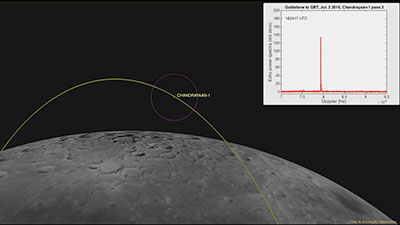 Above: This computer-generated image depicts the Chandrayaan-1's location at time it was detected by the Goldstone Solar System radar on July 2, 2016. The 120-mile (200-kilometer) wide purple circle represents the width of the Goldstone radar beam at lunar distance. The white box in the upper-right corner of the animation depicts the strength of echo. Inside the radar beam (purple circle), the echo from the spacecraft alternated between being very strong and very weak, as the radar beam scattered from the flat metal surfaces. CREDIT: NASA/JPL-Caltech Add to the mix that the Chandrayaan-1 spacecraft is very small, a cube about five feet (1.5 meters) on each side — about half the size of a smart car. Although the interplanetary radar has been used to observe small asteroids several million miles from Earth, researchers were not certain that an object of this smaller size as far away as the moon could be detected, even with the world's most powerful radars. Chandrayaan-1 proved the perfect target for demonstrating the capability of this technique. While they all use microwaves, not all radar transmitters are created equal. The average police radar gun has an operational range of about one mile, while air traffic control radar goes to about 60 miles. To find a spacecraft 237,000 miles (380,000 kilometers) away, JPL's team used NASA's 70-meter (230-foot) antenna at NASA's Goldstone Deep Space Communications Complex in California to send out a powerful beam of microwaves directed toward the moon. Then the radar echoes bounced back from lunar orbit were received by the 100-meter (330-foot) Green Bank Telescope in West Virginia. Finding a derelict spacecraft at lunar distance that has not been tracked for years is tricky because the moon is riddled with mascons (regions with higher-than-average gravitational pull) that can dramatically affect a spacecraft's orbit over time, and even cause it to have crashed into the moon. JPL's orbital calculations indicated that Chandrayaan-1 is still circling some 124 miles (200 kilometers) above the lunar surface, but it was generally considered "lost." However, with Chandrayaan-1, the radar team utilized the fact that this spacecraft is in polar orbit around the moon, so it would always cross above the lunar poles on each orbit. So, on July 2, 2016, the team pointed Goldstone and Green Bank at a location about 100 miles (160 kilometers) above the moon's north pole and waited to see if the lost spacecraft crossed the radar beam. Chandrayaan-1 was predicted to complete one orbit around the moon every two hours and 8 minutes. Something that had a radar signature of a small spacecraft did cross the beam twice during four hours of observations, and the timings between detections matched the time it would take Chandrayaan-1 to complete one orbit and return to the same position above the moon's pole. The team used data from the return signal to estimate its velocity and the distance to the target. This information was then used to update the orbital predictions for Chandrayaan-1. 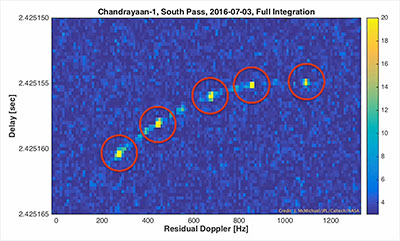 Above: Radar imagery acquired of the Chandrayaan-1 spacecraft as it flew over the moon's south pole on July 3, 2016. The imagery was acquired using NASA's 70-meter (230-foot) antenna at the Goldstone Deep Space Communications Complex in California. This is one of four detections of Chandrayaan-1 from that day. CREDIT: NASA/JPL-Caltech "It turns out that we needed to shift the location of Chandrayaan-1 by about 180 degrees, or half a cycle from the old orbital estimates from 2009," said Ryan Park, the manager of JPL's Solar System Dynamics group, who delivered the new orbit back to the radar team. "But otherwise, Chandrayaan-1's orbit still had the shape and alignment that we expected." Radar echoes from the spacecraft were obtained seven more times over three months and are in perfect agreement with the new orbital predictions. Some of the follow-up observations were done with the Arecibo Observatory in Puerto Rico, which has the most powerful astronomical radar system on Earth. Arecibo is operated by the National Science Foundation with funding from NASA's Planetary Defense Coordination Office for the radar capability. Hunting down LRO and rediscovering Chandrayaan-1 have provided the start for a unique new capability. Working together, the large radar antennas at Goldstone, Arecibo and Green Bank demonstrated that they can detect and track even small spacecraft in lunar orbit. Ground-based radars could possibly play a part in future robotic and human missions to the moon, both for a collisional hazard assessment tool and as a safety mechanism for spacecraft that encounter navigation or communication issues. | |
Contact Us | The Source for Space History & Artifacts
Copyright 2020 collectSPACE.com All rights reserved.

Ultimate Bulletin Board 5.47a
|
|

|
 advertisement advertisement

|




















